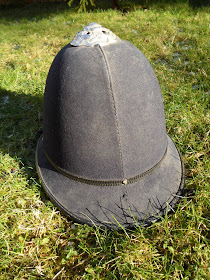To start things off, I thought I'd post a few pictures of the first bikes in my life.........
This is my very first "bike", my little red tricycle. That's me, and I'm guessing I'm about 2 years old.
 This is my first "Real" bicycle....... my green Huffy "stingray" bike! This bike was great. It had ape hanger handle bars, a tall sissy bar in the back, big slick rear race tire, banana seat and very cool flared chrome fenders. I latter "modernized" it with a battery operated turn signal that mounted on the back with a remote switch on the handle bars.
This is my first "Real" bicycle....... my green Huffy "stingray" bike! This bike was great. It had ape hanger handle bars, a tall sissy bar in the back, big slick rear race tire, banana seat and very cool flared chrome fenders. I latter "modernized" it with a battery operated turn signal that mounted on the back with a remote switch on the handle bars.This is me checking out the new bike, age 6 , at our house in Pismo Beach, CA. The second photo is of my Grandpa Bill showing me how to ride it.


Now here's a bike that wasn't actually mine, but almost ended up being mine, as I recall....... This is my sister on her first bike........ a hand-me-down Schwinn girls bike, in front of our house in Pismo Beach.

Now here's the story about my sister's bike and how I almost ended up with it.......
When I was in 6th grade, we lived near Muir Beach and Muir Woods National Monument, over on the coast at the base of Mount Tamalpais (the ancestral home of modern mountain biking!). Our house was part of an old dairy ranch that had been donated to the California State Parks. Well, to get on with the story....... I made a bike jump - ramp out of piled up wood, but didn't want to risk damaging my bike, so I used my sisters bike to catch some air. Well, I ended up cracking the frame of her bike nearly in half! I got in a bit of trouble over that one and was threatened with having to give my bike to my sister and take her bike as my own! I ended up keeping my bike and my sister ended up with a really ugly welded frame with a scrap metal gusset, oh yes and some baby blue touch up paint that didn't quite match........... sorry sis!
Hope you enjoyed the little ride down the old bike path of my past.........




















































